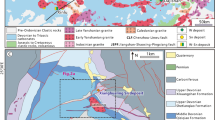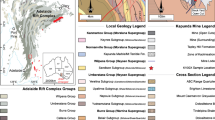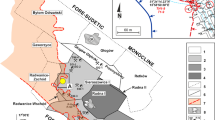Abstract
An integrated geochemical and molecular characterisation of the Cretaceous Lamja Formation shale and coal sediments from the Yola Sub-basin, Northern Benue Trough, northeastern Nigeria, has been undertaken to provide an overview on the origin, richness, hydrocarbon generation potential and paleodepositional conditions. This study is based on geochemical analyses of whole rock (total organic carbon content, pyrolysis, bitumen extraction and biomarker distributions) and vitrinite measurements. The total organic carbon (TOC) contents of the Lamja Formation range from 0.8 to 63 % and 0.8 to 1.16 % for coal and shale samples, respectively, with an average TOC value of 43.87 %. The hydrogen index of these samples ranges from 93.1 to 228 mg hydrocarbon (HC)/g TOC. The kerogen is predominantly type III with a significant mixture of type II kerogens, indicative of mainly gas with limited liquid hydrocarbon-generating potential. The analysed Lamja Formation samples have vitrinite reflectance in the range of 0.57–0.82 %Ro and pyrolysis temperature at maximum (T max) in the range of 435–451 °C which indicate that the samples are thermally mature and entered early mature to peak oil window stage. The molecular geochemical biomarkers are characterised by dominant odd carbon numbered n-alkanes in the range of n-C23 to n-C33, moderately high pristane/phytane (Pr/Ph) ratios (1.77–4.16), very high C27 17α(H)-22,29,30-trisnorhopane/C27 18α(H)-22,29,30-trisnorneohopane (Tm/Ts) ratios (>10) and high concentrations of regular sterane C29, indicating suboxic to oxic conditions, typical of delta plain/coastal marine environment of deposition with prevalent contribution of land plants and minor aquatic organic matter input. The occurrence of oleanane in the analysed samples is also a strong indicator of a terrestrial angiosperm plant source input and the presence of marine influence.












Similar content being viewed by others
References
Abubakar MB (2006). Biostratigraphy, palaeoenvironments and organic geochemistry of the Cretaceous sequences of the Gongola Basin, Upper Benue Trough, PhD unpublished thesis, Abubakar Tafawa Balewa University Bauchi, Nigeria pp. 315
Abubakar MB (2014) Petroleum potentials of the Nigerian Benue Trough and Anambra Basin: a regional synthesis. Nat Res 5(1):25–58
Akande SO, Ojo OJ, Erdtmann BD, Hetenyi M (1998) Paleoenvironments, source rock potential and thermal maturity of the Upper Benue rift basins, Nigeria: implications for hydrocarbon exploration. Org Geochem 29:531–542
Akinlua A, Ajayi TR, Adeleke BB (2007) Organic and inorganic geochemistry of northwestern Niger Delta oils. Geochem J 41:271–281
Alias FL, Abdullah WH, Hakimi MH, Azhar MH, Kugler RL (2012) Organic geochemical characteristics and depositional environment of the Tertiary Tanjong Formation coals in the Pinangah area, onshore Sabah, Malaysia. Int J Coal Geol 104:9–21
Benkhelil J (1982) Benue Trough and Benue Chain. Geol Mag 119(2):158–168
Benkhelil J (1989) The origin and evolution of the Cretaceous Benue Trough (Nigeria). J Afr Earth Sci 8:251–282
Bordenave ML, Espitalié J, Leplat J, Oudin JL, Vandenbroucke M (1993) Screening techniques for source rock evaluation. In: Bordenave ML (ed) Applied petroleum geochemistry. Editions Technip, Paris, pp 217–278
Bray EE, Evans ED (1961) Distribution of n-paraffins as a clue to recognition of source beds. Geochim Cosmochim Acta 22:2–15
Carter JD, Barber W, Tait EA, Jones GP (1963) The geology of parts of the Adamawa, Bauchi and Bornu Provinces in Northeastern Nigeria. Geol Surv Niger Bull 30:53–61
Chandra K, Mishra CS, Samanta U, Gupta A, Mehrotra KL (1994) Correlation of different maturity parameters in the Ahmedabad–Mehsana block of the Cambay basin. Org Geochem 21:313–321
Cranwell PA (1977) Organic geochemistry of Cam Loch (Sutherland) sediments. Chem Geol 20:205–221
Didyk BM, Simoneit BRT, Brassell SC, Eglinton G (1978) Organic geochemical indicators of palaeoenvironmental conditions of sedimentation. Nature 272:216–222
Dzou LI, Holba AG, Ramon JC, Moldowan JM, Zinniker D (1999) Application of new diterpane biomarkers to source, biodegradation and mixing effects on Central Llanos Basin oils, Colombia. Org Geochem 30:515–534
Ebukanson EJ, Kinghorn RRF (1986) Maturity of organic matter in the Jurassic of southern England and its relation to the burial history of the sediments. J Pet Geol 93:259–280
Eglinton G, Hamilton RG (1967) Leaf epicuticular waxes. Science 156:1322–1344
Ekweozor CM, Telnaes N (1990) Oleanane parameter: verification by quantitative study of the biomarker occurrence in sediments of the Niger Delta. Org Geochem 16:401–413
Espitalié J, Madec M, Tissot B (1980) Role of mineral matrix in kerogen pyrolysis: influence on petroleum generation and migration. AAPG Bull 64:59–66
Espitalié J, Deroo, G, Marquis, F. (1985). La pyrolyse Rock-Eval et ses applications. Oil and Gas Sci Technol 40(5):563–579
Grant NK (1971) South Atlantic, Benue Trough and Gulf of Guinea Cretaceous triple junction. Bull Geol Soc Am 82:2295–2298
Guiraud R, Maurin JE (1992) Early Cretaceous rifts of Western and Central Africa: an overview. In: Ziegler PA (eds) Geodynamics of rifting, volume II. Case history studies on rifts: North and South America and Africa. Tectonophysics, 213, 153–168
Hakimi MH, Wan Hasiah A (2013) Organic geochemical characteristics and oil generating potential of the Upper Jurassic Safer shale sediments in the Marib-Shabowah Basin, western Yemen. Org Geochem 54:115–124
Hakimi MH, Wan HA, Shalaby MR (2011) Organic geochemical characteristics and depositional environments of the Jurassic shales in the Masila Basin of Eastern Yemen. GeoArabia 16:47–64
Holba AG, Dzoub LI, Wood GD, Ellisd L, Adame P, Schaeffere P, Albrechte P, Greenef T, Hughes WB (2003) Application of tetracyclic polyprenoids as indicators of input from fresh-brackish water environments. Org Geochem 34:441–469
Huang WY, Meinschein WG (1979) Sterols as ecological indicators. Geochim Cosmochim Ac 43:739–745
Hunt JM (1995) Petroleum geochemistry and geology. W.H. Freeman, New York
King LC (1950) Outline and distribution of Gondwanaland. Geol Magazine 87:353–359
Korkmaz S, Kara Gülbay R (2007) Organic geochemical characteristics and depositional environments of the Jurassic coals in the eastern Taurus of Southern Turkey. Int J Coal Geol 70:292–304
Large DJ, Gize AP (1996) Pristane/phytane ratios in the mineralized Kupferschiefer of the Fore-Sudetic Monocline, southwest Poland. Ore Geol Rev 11:89–103
Mackenzie AS, Patience RL, Maxwell JR, Vandenbroucke M, Durand B (1980) Molecular parameters of maturation in the Toarcian shales, Paris Basin, France—I. Changes in the configurations of acyclic isoprenoid alkanes, steranes, and triterpanes. Geochim Cosmochim Acta 44:1709–1721
Meyers PA, Snowdon LR (1993) Types and maturity of organic matter accumulated during Early Cretaceous subsidence of the Ex-mouth Plateau, Northwest Australia margin. AAPG Stud Geol 37:119–130
Mukhopadhyay PK, Wade JA, Kruge MA (1995) Organic facies and maturation of Jurassic/Cretaceous rocks, and possible oil-source rock correlation based on pyrolysis of asphaltenes, Scotion Basin, Canada. Org Geochem 22:85–104
Murray AP, Boreham CJ (1992) Organic geochemistry in petroleum exploration. Australian Geological Survey Organization, Canberra, p 230
Murray AP, Sosrowidjojo IB, Alexander R, Kagi RI, Norgate CM, Summons RE (1997) Oleananes in oils and sediments: evidence of marine influence during early diagenesis? Geochim Cosmochim Acta 61:1261–1276
Nwajide CS (2013) Geology of Nigeria’s sedimentary basins. CSS Bookshops Ltd, Lagos, p 565
Obaje NG, Wehner H, Abubakar MB, Isah MT (2004) Nasara 1 well Gongola Basin (Upper Benue Trough, Nigeria): source rock evaluation. J Pet Geol 27(2):191–206
Obaje NG, Attah DO, Opeloye SA, Moumouni A (2006) Geochemical evaluation of the hydrocarbon prospects of sedimentary basins in Northern Nigeria. Geochem J 40:227–243
Offodile ME (1976) The geology of the Middle Benue, Nigeria, special volume 4. Palaeontological Institution of the University of Uppsala, Sweden, pp 1–116
Olade MA (1975) Evolution of Nigeria’s Benue Trough: a tectonic model. Geol Mag 112:575–583
Peters KE (1986) Guidelines for evaluating petroleum source rocks using programmed pyrolysis. AAPG Bull 70:318–329
Peters KE, Cassa MR (1994) Applied source rock geochemistry. In: Magoon LB, Dow WG (eds) The petroleum system—from source to trap. American Association of Petroleum Geologists, Memoir, 60, pp. 93–120
Peters KE, Moldowan JM (1993) The biomarker guide: interpreting molecular fossils in petroleum and ancient sediments. Prentice-Hall, Englewood Cliffs
Peters KE, Walters CC, Moldowan JM (2005) The biomarker guide: biomarkers and isotopes in petroleum exploration and Earth history, vol 2, secondth edn. Cambridge University Press, Cambridge
Powell TG, McKirdy DM (1973) Relationship between ratio of pristane to phytane, crude oil composition and geological environment in Australia. Nature 243:37–39
Rinna J, Rullkötter J, Stein R (1996) Hydrocarbons as indicators for provenance and thermal history of organic matter in late Cenozoic sediments from Hole 909C, Fram Strait. Proc Ocean Drill Program Sci Results 151:407–414
Sarki Yandoka BM, Abubakar MB, Abdullah WH, Amir Hassan MH, Adamu BU, Jitong JS, Aliyu AH, Adegoke AK (2014) Facies analysis, palaeoenvironmental reconstruction and stratigraphic development of the Early Cretaceous sediments (Lower Bima Member) in the Yola Sub-basin, Northern Benue Trough, NE Nigeria. J Afr Earth Sci 96:168–179
Seifert WK, Moldowan JM (1978) Applications of steranes, terpanes and monoaromatics to the maturation, migration and source of crude oils. Geochim Cosmochim Acta 42:77–95
Seifert WK, Moldowan JM (1981) Palaeoreconstruction by biological markers. Geochim Cosmochim Acta 45:783–94
Seifert WK, Moldowan JM (1986). Use of biological markers in petroleum exploration. In: Johns RB (ed) Vol. 24. Amsterdam: Methods in Geochemistry and Geophysics Book Series, p. 261–90
Stein R (1991) Accumulation of organic carbon in marine sediments. Results from the Deep Sea Drilling Project Ocean Drilling Program (DSDP (ODP)). Lect. Notes Earth Sci. 34. Springer e Verlag, Heidelberg
Stoneley R (1966) The niger delta region in the light of the theory of continental drift. Geol Mag 103:385–397
Taylor GH, Teichmüller M, Davis A, Diessel CFK, Littke R, Robert P (1998) Organic petrology. Gebruder Borntraeger, Berlin, p 704
Tissot BP, Welte DH (1984) Petroleum formation and occurrence. Springer, Berlin, p 518
Volkman JK (1986) A review of sterol biomarkers for marine and terrigenous organic matter. Org Geochem 9:83–89
Waples DW, Machihara T (1991) Biomarkers for geologists: a practical guide to the application of steranes and triterpanes in petroleum geology. American Association of Petroleum Geologists Methods in Exploration 9, Tulsa
Wright JB (1976) Volcanic rocks in Nigeria. In: Kogbe CA (ed) Geology of Nigeria. Elizabethan Publication Company, Lagos, pp 93–142
Zarboski PF, Ugodulunwa A, Idornigie P, NnaboK I (1997) Stratigraphy and structure of the Cretaceous Gongola Basin, Northeast Nigeria. Bull Centres Res Explor Prod El fAquataine 21(1):154–185
Acknowledgments
This study received support from the National Centre for Petroleum Research and Development, Energy Commission of Nigeria (NNBT Project Research Fund), for funding the field trips and sample collection. The research was also funded by the University of Malaya IPPP Research Fund (PG140-2012B). Grateful acknowledgement is given to Miss Hajah Zaleha Abdullah, Mr. Mohamed Zamri Rashid and Mrs. Maisarah Binti Yusoff(Geology Department) for analytical assistance.
Author information
Authors and Affiliations
Corresponding author
Appendix
Appendix
Rights and permissions
About this article
Cite this article
Sarki Yandoka, B.M., Abdullah, W.H., Abubakar, M.B. et al. Organic geochemical characteristics of Cretaceous Lamja Formation from Yola Sub-basin, Northern Benue Trough, NE Nigeria: implication for hydrocarbon-generating potential and paleodepositional setting. Arab J Geosci 8, 7371–7386 (2015). https://doi.org/10.1007/s12517-014-1713-3
Received:
Accepted:
Published:
Issue Date:
DOI: https://doi.org/10.1007/s12517-014-1713-3




